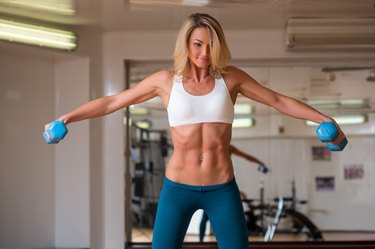
Dumbbells make great workout tools when you are trying to get into better shape. Not only are they inexpensive compared to machines, but they also cause you to work stabilizing muscles while focusing on a primary muscle, which helps speed up your progress. The actual muscles that get worked vary, depending on what exercise you do. Because dumbbells are free to move, every major muscle in the the body can be targeted.
Chest, Shoulders and Triceps
Video of the Day
Compound exercises work more than one muscle group at a time. Dumbbell bench presses fall into this category, working the pectorals, deltoids and triceps. The pecs are the large chest muscles, and they have a fan shape. The deltoids surround the shoulders and give them a rounded look. The triceps are on the back of the upper arms.
Video of the Day
Trapezius
The trapezius is a large muscle that starts at the base of the neck and goes down into the middle of the back and out over the collarbones. A dumbbell shrug exercise works this major upper body muscle. You also end up working a minor muscle on the side of the neck called the levator scapulae. In similar fashion to the traps, this muscle gets activated when you elevate your shoulders.
Biceps
The biceps form a rounded mound on the front of the large humerus bone in the upper arm when they are contracted. You work these muscles by doing a motion called elbow flexion. This takes place when you decrease the angle between your forearm and upper arm. Dumbbell curls involve this motion and work the biceps. By turning your palms down with dumbbell curls, you perform reverse curls. This places more emphasis on the brachioradialis muscle, which starts under the biceps and runs down the top of the forearm.
Latissimus Dorsi
The lats start in the lower back and flare out to the top sides of the back in a "V" shape. Bent-over rows work this large muscle group. When you pull the weights up to your lower stomach with this exercise, you have to draw your shoulder blades inward. This causes you to also work the rhomboids major and minor, which sit between the shoulders.
Glutes, Quadriceps and Hamstrings
The glutes consist of the gluteus maximus, medius and minimus, which are your buttock muscles. The quadriceps sit on the front of the thighs and the hamstrings start under the glutes and run down to the knees on the back of the thighs. All of these muscles get worked with dumbbell lunges. The motions that activate these muscles are hip extension and flexion, and knee extension and flexion. Hip extension takes place when you move your thigh backward, and hip flexion takes place when you move your thigh forward. Knee flexion occurs when you bend your knee and move your foot backward, and knee extension takes place when you straighten your leg.
Calves
The gastrocnemius is the two-part calf muscle that has a lateral and medial head. Both parts sit right under the knee on the back of the leg and they get worked when you do dumbbell calf raises from a standing position. The soleus is the other part of the calves, and it sits right in front of the gastroc. A seated calf raise with one or two dumbbells resting on your thighs places most of the emphasis on this muscle.